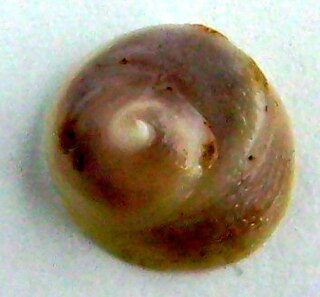
The song thrush is a thrush that breeds across the West Palearctic. It has brown upper-parts and black-spotted cream or buff underparts and has three recognised subspecies. Its distinctive song, which has repeated musical phrases, has frequently been referred to in poetry.

Powelliphanta is a genus of large, air-breathing land snails, pulmonate gastropods in the family Rhytididae, found only in New Zealand. They are carnivorous, eating invertebrates, mostly native earthworms. Often restricted to very small areas of moist forest, they are prey to introduced mammalian predators, and many species are threatened or endangered.

Molluscicides – also known as snail baits, snail pellets, or slug pellets – are pesticides against molluscs, which are usually used in agriculture or gardening, in order to control gastropod pests specifically slugs and snails which damage crops or other valued plants by feeding on them.

Kahurangi National Park in the northwest of the South Island of New Zealand is the second largest of the thirteen national parks of New Zealand. It was gazetted in 1996 and covers 4,529 square kilometres (1,749 sq mi), ranging to near Golden Bay in the north. Much of what was the North-west Nelson Forest Park formed the basis of the new park. Kahurangi Point, regarded as the boundary between the West Coast and Tasman Regions, is located in the park, as is Mount Owen. The main tramping tracks in the park are the Heaphy Track and the Wangapeka Track.
Richard Kenneth Dell was a New Zealand malacologist.

The New Zealand mud snail is a species of very small freshwater snail with a gill and an operculum. This aquatic gastropod mollusk is in the family Tateidae.

Captain Frederick Wollaston Hutton was an English-New Zealand scientist who applied the theory of natural selection to explain the origins and nature of the natural history of New Zealand. An army officer in early life, he then had an academic career in geology and biology. He became one of the most able and prolific nineteenth century naturalists of New Zealand.

Paryphanta is a genus of land snails in the family Rhytididae. Species from New Zealand are known commonly as kauri snails. They are closely related and similar to snails in the genus Powelliphanta, which was formerly included within Paryphanta.

Rhytididae is a taxonomic family of medium-sized predatory air-breathing land snails, carnivorous terrestrial pulmonate gastropod molluscs in the superfamily Rhytidoidea.

Powelliphanta augusta or the Mount Augustus snail, previously provisionally known as Powelliphanta "Augustus", is a species of large, carnivorous land snail, a terrestrial pulmonate gastropod mollusc in the family Rhytididae. Naturally occurring only on Mount Augustus near Westport on New Zealand's South Island, their entire habitat was destroyed by coal mining. The world population was taken into captivity, in theory until their habitat was restored and they could be released. The mining company concerned went bankrupt and habitat restoration has been unsuccessful, so the species' future is uncertain.

A plait is an anatomical feature which is present the shells of some snails, or gastropods. This sculpture occurs often in the shells of marine gastropod mollusks in the clade Neogastropoda, but it is also found in some pulmonate land snails.

The Calyptraeidae are a family of small to medium-sized marine prosobranch gastropods.

A land snail is any of the numerous species of snail that live on land, as opposed to the sea snails and freshwater snails. Land snail is the common name for terrestrial gastropod mollusks that have shells. However, it is not always easy to say which species are terrestrial, because some are more or less amphibious between land and fresh water, and others are relatively amphibious between land and salt water.

Achatinellidae is a family of tropical air-breathing land snails, terrestrial pulmonate gastropod mollusks in the superfamily Pupilloidea.

Hipponix, common name hoof snails or hoof shells, is a genus of small sea snails with limpet-like shells, marine gastropod molluscs in the family Hipponicidae, the hoof snails. Many of the species in this genus have white shells.

Cancellariidae, common name the nutmeg snails or nutmeg shells, are a family of small to medium-large sea snails, marine gastropod mollusks in the clade Neogastropoda. Some of the shells of the species in this family resemble a nutmeg seed.

Placostylus ambagiosus is a species of flax snail, a large air-breathing land snail, a terrestrial pulmonate gastropod mollusc in the family Bothriembryontidae.

The Braeburn Range is a mountain range in the Tasman Region of New Zealand's South Island. It lies to the west of Lake Rotoroa and much of the eastern flank of the range is within the Nelson Lakes National Park. The range runs south-southeast, with a westwards curve at the northern end and several westward-trending spurs.
















